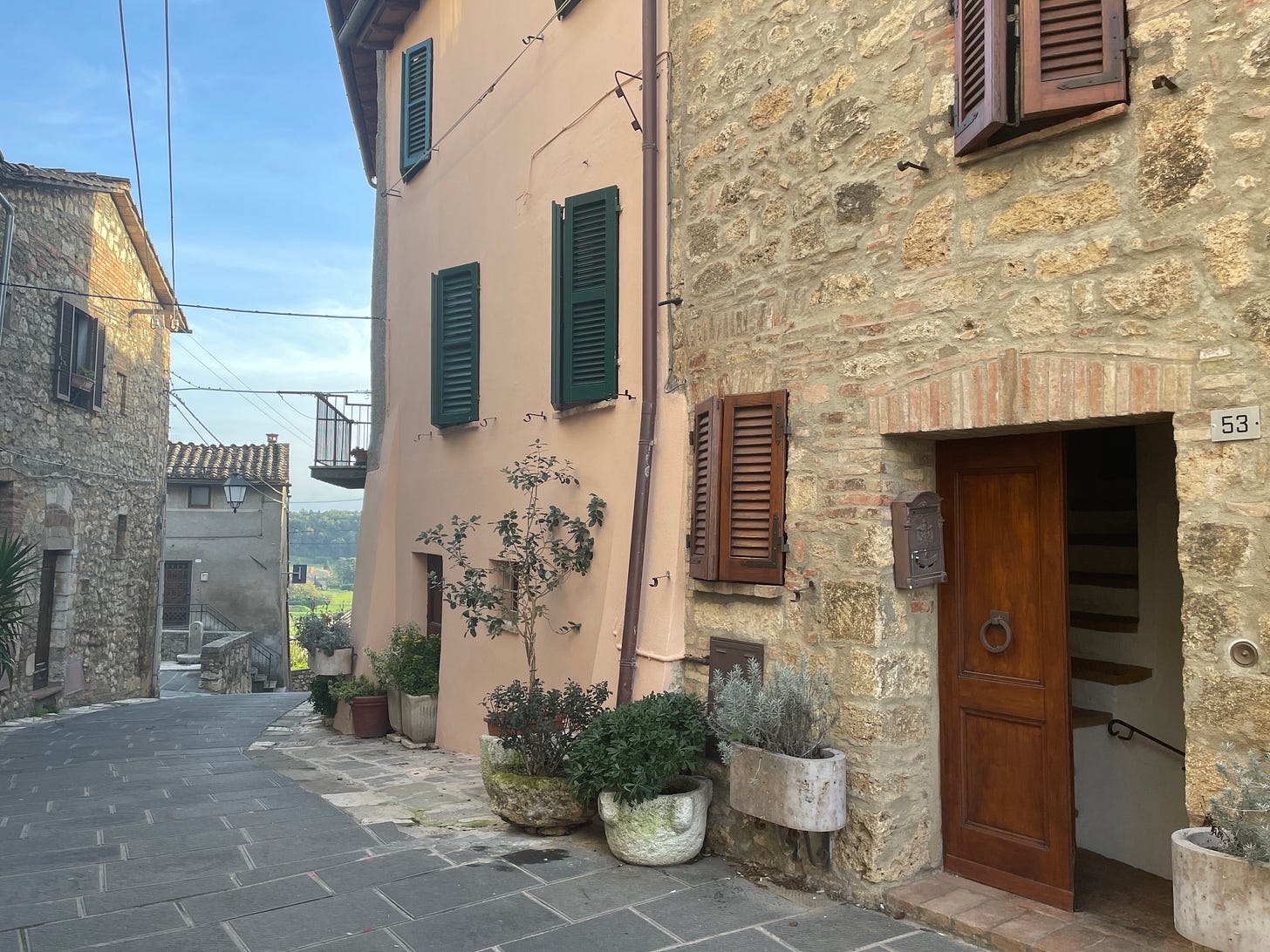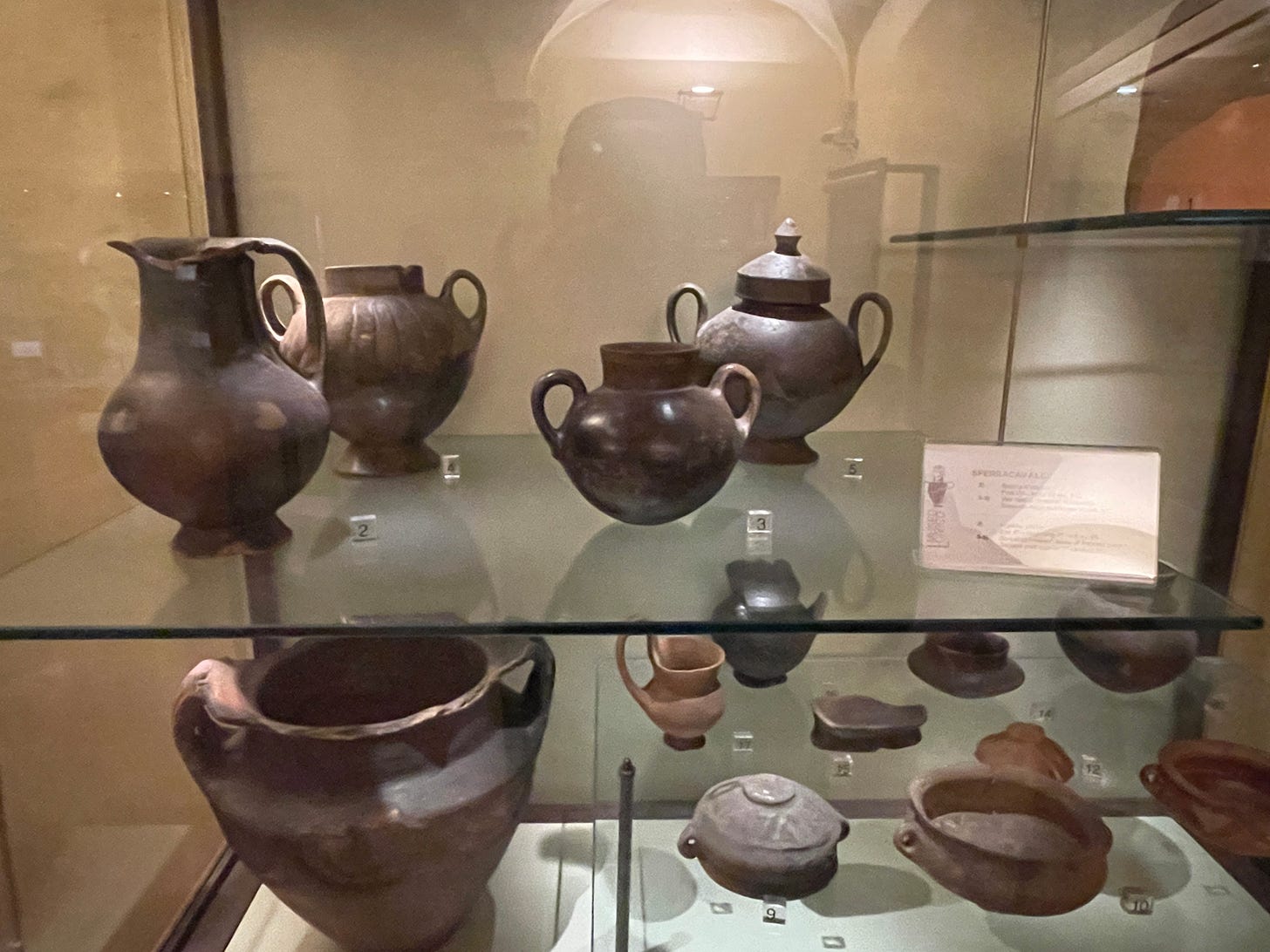From Etruria
A.K.A. Tuscany
No. 53, Via Forti/San Angelo. That’s the house where we’re staying in Sarteano, Tuscany, Italy, looking east, down toward the piazza
__________
We’re in one of those “Etruscan Places” D. H. Lawrence described in his 1927 book of that name, the little town (or “comune”) of Sarteano, in Tuscany, southwest of Florence/Firenze and Siena.
The local museum is devoted entirely to the archaeological evidence of the centuries before Romans created their republic and decided they needed to conquer and cultivate the fertile lands to the north, also the people, those Etruscans, or Tyyhrenians, who lived there. The funerary artifacts give way to vases, vessels, plates, and other devices of the living in the 6th and 5th centuries BC; these strongly resemble those crafted and painted in Attica of the same classical moment, which makes perfect sense in view of the thriving commerce that had connected the two regions since the dawn of the Iron Age. (It seems the Etruscans were trading with the Celts, too, and long before the Roman Empire got around to it.)
Artifacts from tombs, ca. 6th century B.C., displayed in the local museum, Sarteano
__________
Lawrence detested the Romans because they had pretty much erased the evidence of a civilization that apparently had no imperial ambitions or designs, nor was capable of feeling shame about sexuality in any of its polymorphous permutations. By 1927, when he made his last pilgrimage to Italy, only the subterranean cities of the Etruscan dead remained, and these necropolises had been stripped over centuries by indiscriminate looters; so the places he visited were commemorative, compensatory scenes of life after death that were twice removed from the living.
Here is how this sad journey begins: “The Etruscans, everyone knows, were the people who occupied the middle of Italy in early Roman days and whom the Romans, in their usual neighbourly fashion, wiped out entirely to make room for Rome with a capital R. . . . Now, we know nothing about the Etruscans except what we find in their tombs. There are references to them in Latin writers. But of first-hand knowledge we have nothing except what the tombs offer. So to the tombs we must go: or the museums containing the things that have been rifled from the tombs.”
Most of the following tour is boring description of travel across a desolate landscape by improvised means—inventories of the places either ravaged or forgotten by modernity. Lawrence rouses himself from his sullen, admonitory mood only when he’s celebrating the vitality of the Etruscan underworld or comparing imaginary Etruscans, who are always naked, singing, and dancing, to actual Italian peasants, who are usually filthy, weary, and dressed in drab, returning from the lord’s fields at dusk. On those occasions, he can happily scold the contemporary world for its Roman (a.k.a. Puritan) morality, which blights fascists and their enemies alike. [pp. 31-32, 56, 82-95]
There is no middle ground or ages here: the spaces between the tombs are covered with boilerplate or idle chatter; the time passed between the Roman conquest of the Etruscans and the present counts for nothing, not even the big event known as the Renaissance, the headquarters of which was Firenze (just 62 km from where I’m sitting in Sarteano). This is typical of romantic and reactionary narratives, which posit a moment of beautiful equilibrium in the distant past—a social order and cultural poise based on a “natural” hierarchy—and proceed to measure the present’s distance from that irretrievable place of instinctive, untaught grace. That is the ineluctable tragedy of history. Here’s a sample of Lawrence’s contribution to the genre:
“Probably in Etruscan days the peasants came in very much the same, at evening, to the town. The Etruscans were instinctively citizens. Even the peasants dwelt within walls. And in those days, no doubt, the peasants were serfs very much as they are today in Italy. . . . But in those days, on a fine evening like this, the men would come in naked, darkly ruddy-coloured from the sun and wind with strong, insouciant bodies, and the women would drift in wearing the loose, becoming smock of white or blue linen and somebody, surely, would be playing on the pipes, and somebody, surely, would be singing, because the Etruscans had a passion for music, and an inner carelessness the modern Italians have lost. . . . It is different now. The drab peasants, muffled in ugly clothing, straggle in across the waste bit of space, and trail home, songless and meaningless. We have lost the art of living; and in the most important science of all, the science of daily life, the science of behaviour, we are complete ignoramuses.” [pp. 93-95, from Chapter 4, “The Painted Tombs of Tarquinia”]
It was once upon a time and only once, this fleeting Etruscan moment: it couldn’t last. “It is as if the current of some strong different life swept through them, different from our shallow current today: as if they drew their vitality from different depths that we are denied. Yet in a few centuries they lost their vitality. The Romans took the life out of them.” [p. 82]
The chariot of the dead, a fresco painting from the wall of an Etruscan tomb, ca. 6th century B.C, beneath the local museum, Sarteano: “The underworld of the Etruscans was a gay place. . . . This profound belief in life, acceptance of life, seems characteristic of the Etruscans. It is still vivid in the painted tombs.” [D. H. Lawrence, Etruscan Places (1927), p. 70]
__________
We’re happy to be here in the present, even on a rainy day. The map makes the town seem huge, but everything is within a five-minute walk, although getting to the grocery store or the coffee shop is easier than getting back, because the return trip is all uphill (and it’s a 30-40 degree incline: that castle was built atop the hill so its defenders could see the approach of the enemy).
On our way back from provisioning.
__________
The castle that rises above our borrowed residence here, whose two stories sit on the ruins of an outer turret. I took this picture from the street, outside our front door. Built in 1036 (according to lore), razed and rebuilt under Siena’s auspices in the late 14th century, besieged by Caesar Borgia in 1503, surrendered to Medici control in 1555, bequeathed to the male heirs of Brandimarte Fanelli by Grand Duke Cosimo II in 1617. The Fanelli family sold it to the comune of Sarteano in 1998.





